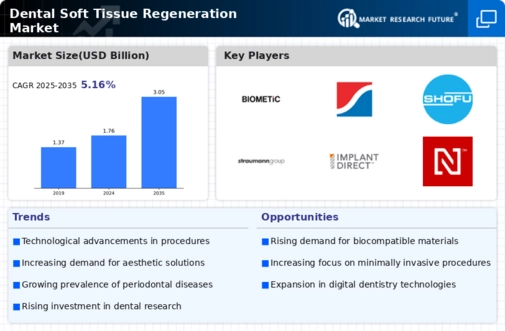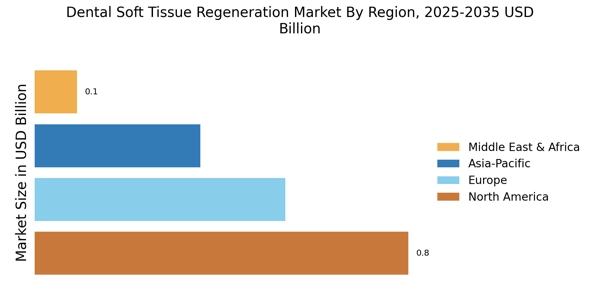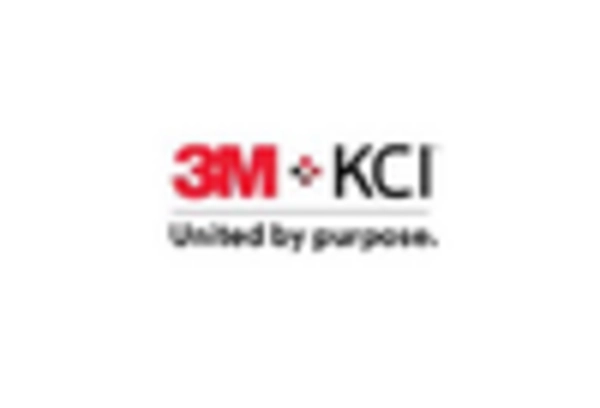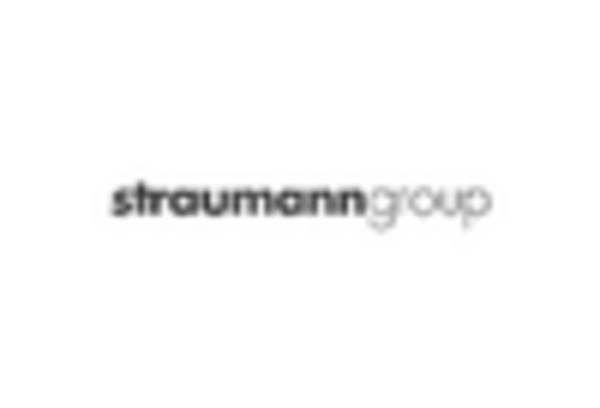Surge in Aesthetic Dentistry
The increasing focus on aesthetic dentistry is significantly influencing the Dental Soft Tissue Regeneration Market. Patients are becoming more conscious of their oral appearance, leading to a surge in demand for procedures that enhance the aesthetics of the smile. Soft tissue regeneration plays a crucial role in procedures such as gum contouring and smile makeovers, where the appearance of the gums is as important as that of the teeth. This trend is expected to drive the market, as dental professionals incorporate soft tissue regeneration techniques into their aesthetic offerings. The Dental Soft Tissue Regeneration Market is likely to benefit from this shift, with an anticipated increase in product development aimed at meeting the aesthetic needs of patients.
Growing Awareness of Oral Health
There is a growing awareness of oral health and its connection to overall well-being, which is positively impacting the Dental Soft Tissue Regeneration Market. Educational campaigns and increased access to dental care are leading to more individuals seeking preventive and restorative treatments. As patients become more informed about the importance of maintaining healthy gums, the demand for soft tissue regeneration solutions is likely to rise. This heightened awareness is expected to drive market growth, as dental professionals emphasize the significance of soft tissue health in preventing systemic diseases. The Dental Soft Tissue Regeneration Market stands to benefit from this trend, as it aligns with the broader movement towards holistic health and wellness.
Advancements in Regenerative Techniques
The Dental Soft Tissue Regeneration Market is experiencing a notable transformation due to advancements in regenerative techniques. Innovations in surgical methods, such as guided tissue regeneration and the use of growth factors, are enhancing the efficacy of soft tissue repair. These techniques not only improve clinical outcomes but also reduce recovery times for patients. The market is projected to grow at a compound annual growth rate of approximately 8% over the next few years, driven by these advancements. As practitioners adopt these innovative methods, the demand for specialized products and services within the Dental Soft Tissue Regeneration Market is likely to increase, reflecting a shift towards more effective and patient-centered care.
Increasing Prevalence of Periodontal Diseases
The rising incidence of periodontal diseases is a critical driver for the Dental Soft Tissue Regeneration Market. With a significant portion of the adult population affected by gum diseases, the need for effective treatment options is paramount. According to recent studies, nearly 50% of adults over the age of 30 exhibit some form of periodontal disease, necessitating interventions that promote soft tissue regeneration. This growing patient base is likely to stimulate demand for regenerative products and services, as dental professionals seek to address these conditions effectively. Consequently, the Dental Soft Tissue Regeneration Market is poised for growth as practitioners increasingly recognize the importance of soft tissue health in overall oral wellness.
Technological Integration in Dental Practices
The integration of advanced technologies in dental practices is reshaping the Dental Soft Tissue Regeneration Market. Digital tools such as 3D imaging and computer-aided design are enhancing the precision of soft tissue procedures. These technologies allow for better planning and execution of regenerative treatments, leading to improved patient outcomes. As dental practices adopt these innovations, the demand for related products and services is expected to rise. Furthermore, the ability to provide personalized treatment plans through technology is likely to attract more patients seeking soft tissue regeneration solutions. This trend indicates a promising future for the Dental Soft Tissue Regeneration Market, as technology continues to play a pivotal role in enhancing clinical practices.


















Leave a Comment